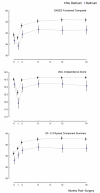Trajectory of Functional Recovery After Postoperative Delirium in Elective Surgery
- PMID: 27501176
- PMCID: PMC5292310
- DOI: 10.1097/SLA.0000000000001952
Trajectory of Functional Recovery After Postoperative Delirium in Elective Surgery
Abstract
Objective: To describe functional recovery after elective surgery and to determine whether improvements differ among individuals who develop delirium.
Background: No large studies of older adults have investigated whether delirium influences the trajectory of functional recovery after elective surgery. The prospective observational study assessed this association among 566 individuals aged 70 years and older.
Methods: Patients undergoing major elective surgery were assessed daily while in hospital for presence and severity of delirium using the Confusion Assessment Method, and their functional recovery was followed for 18 months thereafter. The Activities of Daily Living and Instrumental Activities of Daily Living Scales and the Physical Component Summary of the Short Form-12 were obtained before surgery and at 1, 2, 6, 12, and 18 months. A composite index (standard deviation 10, minimally clinically significant difference 2) derived from these scales was then analyzed using mixed-effects regression.
Results: Mean age was 77 years; 58% of participants were women and 24% developed postoperative delirium. Participants with delirium demonstrated lesser functional recovery than their counterparts without delirium; at 1 month, the covariate-adjusted mean difference on the physical function composite was -1.5 (95% confidence interval -3.3, -0.2). From 2 to 18 months, the corresponding difference was -1.8 (95% confidence interval -3.2, -0.3), an effect comparable with the minimally clinically significant difference.
Conclusions: Delirium was associated with persistent and clinically meaningful impairment of functional recovery, to 18 months. Use of multifactorial preventive interventions for patients at high risk for delirium and tailored transitional care planning may help to maximize the functional benefits of elective surgery.
Figures
Comment in
-
Incorporating Patient-centered Outcomes Into Surgical Care.Ann Surg. 2017 Apr;265(4):654-655. doi: 10.1097/SLA.0000000000002038. Ann Surg. 2017. PMID: 27735822 No abstract available.
References
-
- Witlox J, Eurelings LS, de Jonghe JF, Kalisvaart KJ, Eikelenboom P, van Gool WA. Delirium in elderly patients and the risk of postdischarge mortality, institutionalization, and dementia: A meta-analysis. JAMA. 2010;304:443–451. - PubMed
-
- Pandharipande PP, Girard TD, Ely EW. Long-term cognitive impairment after critical illness. N Engl J Med. 2014;370:185–186. - PubMed
-
- Quinlan N, Rudolph JL. Postoperative delirium and functional decline after noncardiac surgery. J Am Geriatr Soc. 2011;59(Suppl 2):S301–304. - PubMed
Publication types
MeSH terms
Grants and funding
LinkOut - more resources
Full Text Sources
Other Literature Sources
Medical


